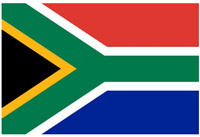World's Ten Most Colorful Flags
World's 10 Most Colorful Flags
Here are ten of the most colorful flags from around the world.
While it is fairly common for flags to have just three colors, like the red, white, and blue of the United States or the black, red, and gold of Germany, some flags are much more colorful than that. What makes a flag colorful tends to be a subjective decision, however. There are many flags that use eight or more colors in them, but because the majority of the colors appear in small sections of a coat of arms, it just doesn't seem that colorful. Likewise, other flags may only have three or four colors, but a complex primary design or prominent display of the colors makes the flags appear to be extremely colorful.
Here are ten of the world's most colorful flags. For our purposes here, we have considered design as well as the number of colors in selecting the most colorful country flags. And be sure to read about what these flag colors represent.
Here are ten of the most colorful flags from around the world.
While it is fairly common for flags to have just three colors, like the red, white, and blue of the United States or the black, red, and gold of Germany, some flags are much more colorful than that. What makes a flag colorful tends to be a subjective decision, however. There are many flags that use eight or more colors in them, but because the majority of the colors appear in small sections of a coat of arms, it just doesn't seem that colorful. Likewise, other flags may only have three or four colors, but a complex primary design or prominent display of the colors makes the flags appear to be extremely colorful.
Here are ten of the world's most colorful flags. For our purposes here, we have considered design as well as the number of colors in selecting the most colorful country flags. And be sure to read about what these flag colors represent.
As the only nation to use six colors in their flag's primary design, South Africa gets first place on our list of the world's most colorful flags. The flag's design is made up of a green horizontal Y, positioned so that the Y touches both the upper and lower left corners of the flag. The triangular shape along the leftmost end of the flag is black with a yellow border. On the right side of the flag, the area above the Y is red, and the area below is blue, both with a white border. The colors and the Y design are meant to represent the convergence of two separate paths: those of the South Africans, and those of the Europeans who colonized the country.
Turkmenistan
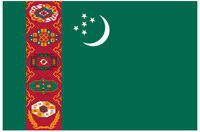
Although with four colors in its design, Turkmenistan's flag is far from having the most colors. It does have the honor of being the most intricate of all the national flags in the world. The flag is primarily green, but with a wide vertical stripe near the left end of the flag. This stripe is primarily red, with five tribal patterns that are used in designing the traditional rugs the country is known for. Orange, white, red, and green can be found in the tribal designs, with a white crescent moon encompassing five white five-pointed stars on the field of green to the right of the stripe, near the top of the flag. Obviously, the five tribal designs represent the country's traditional heritage, while the five stars stand for the five regions of the nation.
Saint-Pierre and Miquelon
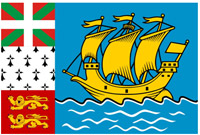
Turkmenistan

Although with four colors in its design, Turkmenistan's flag is far from having the most colors. It does have the honor of being the most intricate of all the national flags in the world. The flag is primarily green, but with a wide vertical stripe near the left end of the flag. This stripe is primarily red, with five tribal patterns that are used in designing the traditional rugs the country is known for. Orange, white, red, and green can be found in the tribal designs, with a white crescent moon encompassing five white five-pointed stars on the field of green to the right of the stripe, near the top of the flag. Obviously, the five tribal designs represent the country's traditional heritage, while the five stars stand for the five regions of the nation.
Saint-Pierre and Miquelon

The flag of Saint-Pierre and Miquelon is a very interesting and complicated flag. Designed in 1982, this flag is actually a local flag, with the flag of France used as the islands' official flag. The design depicts a yellow ship on a light blue background with waves drawn in black and white, with three flags forming a narrow border along the leftmost side of the flag: a white, green, and red design in the top third, a black and white design in the middle third, and two yellow lions on a red background in the bottom third. The ship represents the colonization of the islands beginning in 1535, while the three individual designs stand for the origins of the islands' colonists: Basque Country (top), Brittany (middle), and Normandy (bottom).
Central Africa
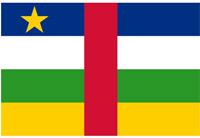
The Central African Republic uses five colors in their flag: blue, white, green, yellow, and red. The colors are boldly blocked out in four horizontal stripes of the first four colors, bisected by a single vertical stripe in red. All of the stripes are the same width. In the upper left hand corner, on the leftmost end of the blue stripe, is a single yellow five-point star. Like many nations' flags, the colors represent various pieces of the country's history: The colors are those of the Pan-African and French flags combined, with the red stripe present to represent the bloodshed in the battle for independence. The star is there as a reminder of the hopes for a great future.
Dominica
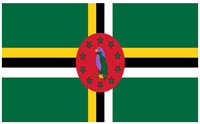
The country of Dominica uses six different colors, but not all of those colors are used in the flag's primary design. The flag features a centered cross of yellow, black, and white stripes, with a green background. In the center of the cross is a red medallion, representing social justice, with a light blue, green, red, and yellow local parrot on it. Surrounding the parrot are ten green stars, representing the country's ten parishes. The cross stands for the Christian trinity, with each of the three colors representing a different part of the country's economy and heritage.
Zimbabwe
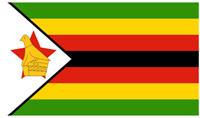
Like Central Africa, Zimbabwe's flag uses five different colors, but the complex design makes it seem very busy and colorful. The flag has seven horizontal stripes with colors alternating in the following order: green, yellow, red, black, red, yellow, and green. Superimposed over the stripes on the left end of the flag is a white triangle that points to the right, with a red star covered by a yellow bird inside the triangle. The bird remembers the country's history, and the central black stripe honors the native people, surrounded by red stripes to represent the fight for independence.
Seychelles
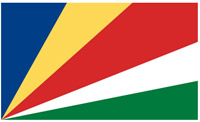
The flag of Seychelles is very interesting, as it features five colors radiating out from the lower left corner. The rays are, in order from the leftmost ray: blue for the sky and the sea, yellow for the sun, red for the people's will to work for unity and love, white for social justice, and green for the land.
Comoros
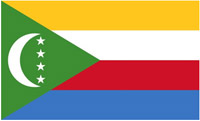
The Comoros flag is another that features five different colors, if you count white as a color. The leftmost half of the flag is taken up with a green triangle, with the point facing toward the right side of the flag. Inside the triangle are a white crescent moon, representing Islam, and four white stars, representing the four main islands. Behind the triangle and covering the rest of the flag are four equal horizontal stripes of yellow, white, red, and blue.
Namibia

Like Comoros and many other flags, the main colors of the flag of Namibia are red, blue, green, yellow, and white. This flag is dissected by a diagonal red stripe, from the lower left corner to the upper right corner, which is bordered with narrow white stripes. The upper left half of the flag is blue, for the sea and the sky, and the lower right is green, for agriculture. A sunburst with 12 small triangular rays is in the upper left corner, on the blue field, representing the country's power.
Grenada

The flag of Grenada is the only one on this list that has only three colors in its design, which is why it comes last. However, the busy design and bright colors of the red, yellow, and green flag of Grenada makes it seem very colorful. The flag has a wide red border, with three yellow stars along the top and three yellow stars along the bottom of the flag. In the middle is a green and yellow rectangle divided into triangles with two intersecting lines: two yellow triangles on top and bottom, and two green triangles on the sides. In the middle, where all the triangle points meet, is a red circle with a yellow five-point star inside of it. To the left, in the green triangle, is a yellow and red nutmeg pod, representing the country's biggest export. The yellow in the flag represents the sun, the green represents agriculture, and the red border stands for the courage of the people, with a star for the capital and one for each of the administrative divisions of the country.
There are many other colorful flags throughout the world -- you can find them all in this list of the flags of the world. Which are your favorites?
Central Africa

The Central African Republic uses five colors in their flag: blue, white, green, yellow, and red. The colors are boldly blocked out in four horizontal stripes of the first four colors, bisected by a single vertical stripe in red. All of the stripes are the same width. In the upper left hand corner, on the leftmost end of the blue stripe, is a single yellow five-point star. Like many nations' flags, the colors represent various pieces of the country's history: The colors are those of the Pan-African and French flags combined, with the red stripe present to represent the bloodshed in the battle for independence. The star is there as a reminder of the hopes for a great future.
Dominica

The country of Dominica uses six different colors, but not all of those colors are used in the flag's primary design. The flag features a centered cross of yellow, black, and white stripes, with a green background. In the center of the cross is a red medallion, representing social justice, with a light blue, green, red, and yellow local parrot on it. Surrounding the parrot are ten green stars, representing the country's ten parishes. The cross stands for the Christian trinity, with each of the three colors representing a different part of the country's economy and heritage.
Zimbabwe

Like Central Africa, Zimbabwe's flag uses five different colors, but the complex design makes it seem very busy and colorful. The flag has seven horizontal stripes with colors alternating in the following order: green, yellow, red, black, red, yellow, and green. Superimposed over the stripes on the left end of the flag is a white triangle that points to the right, with a red star covered by a yellow bird inside the triangle. The bird remembers the country's history, and the central black stripe honors the native people, surrounded by red stripes to represent the fight for independence.
Seychelles

The flag of Seychelles is very interesting, as it features five colors radiating out from the lower left corner. The rays are, in order from the leftmost ray: blue for the sky and the sea, yellow for the sun, red for the people's will to work for unity and love, white for social justice, and green for the land.
Comoros

The Comoros flag is another that features five different colors, if you count white as a color. The leftmost half of the flag is taken up with a green triangle, with the point facing toward the right side of the flag. Inside the triangle are a white crescent moon, representing Islam, and four white stars, representing the four main islands. Behind the triangle and covering the rest of the flag are four equal horizontal stripes of yellow, white, red, and blue.
Namibia

Like Comoros and many other flags, the main colors of the flag of Namibia are red, blue, green, yellow, and white. This flag is dissected by a diagonal red stripe, from the lower left corner to the upper right corner, which is bordered with narrow white stripes. The upper left half of the flag is blue, for the sea and the sky, and the lower right is green, for agriculture. A sunburst with 12 small triangular rays is in the upper left corner, on the blue field, representing the country's power.
Grenada

The flag of Grenada is the only one on this list that has only three colors in its design, which is why it comes last. However, the busy design and bright colors of the red, yellow, and green flag of Grenada makes it seem very colorful. The flag has a wide red border, with three yellow stars along the top and three yellow stars along the bottom of the flag. In the middle is a green and yellow rectangle divided into triangles with two intersecting lines: two yellow triangles on top and bottom, and two green triangles on the sides. In the middle, where all the triangle points meet, is a red circle with a yellow five-point star inside of it. To the left, in the green triangle, is a yellow and red nutmeg pod, representing the country's biggest export. The yellow in the flag represents the sun, the green represents agriculture, and the red border stands for the courage of the people, with a star for the capital and one for each of the administrative divisions of the country.
There are many other colorful flags throughout the world -- you can find them all in this list of the flags of the world. Which are your favorites?
Related Pages:
By Chad Creech, All Star Flags

